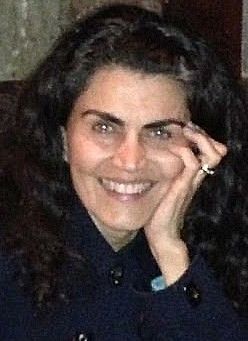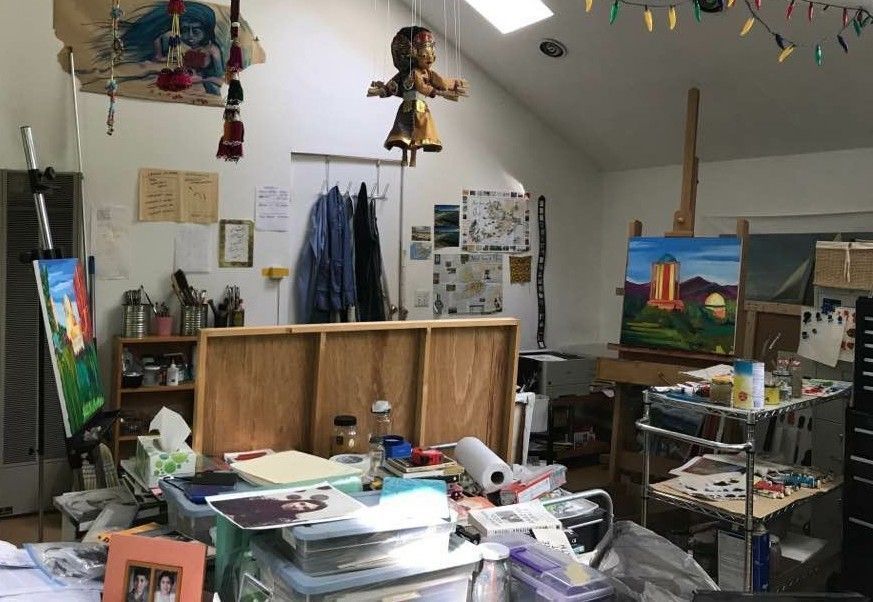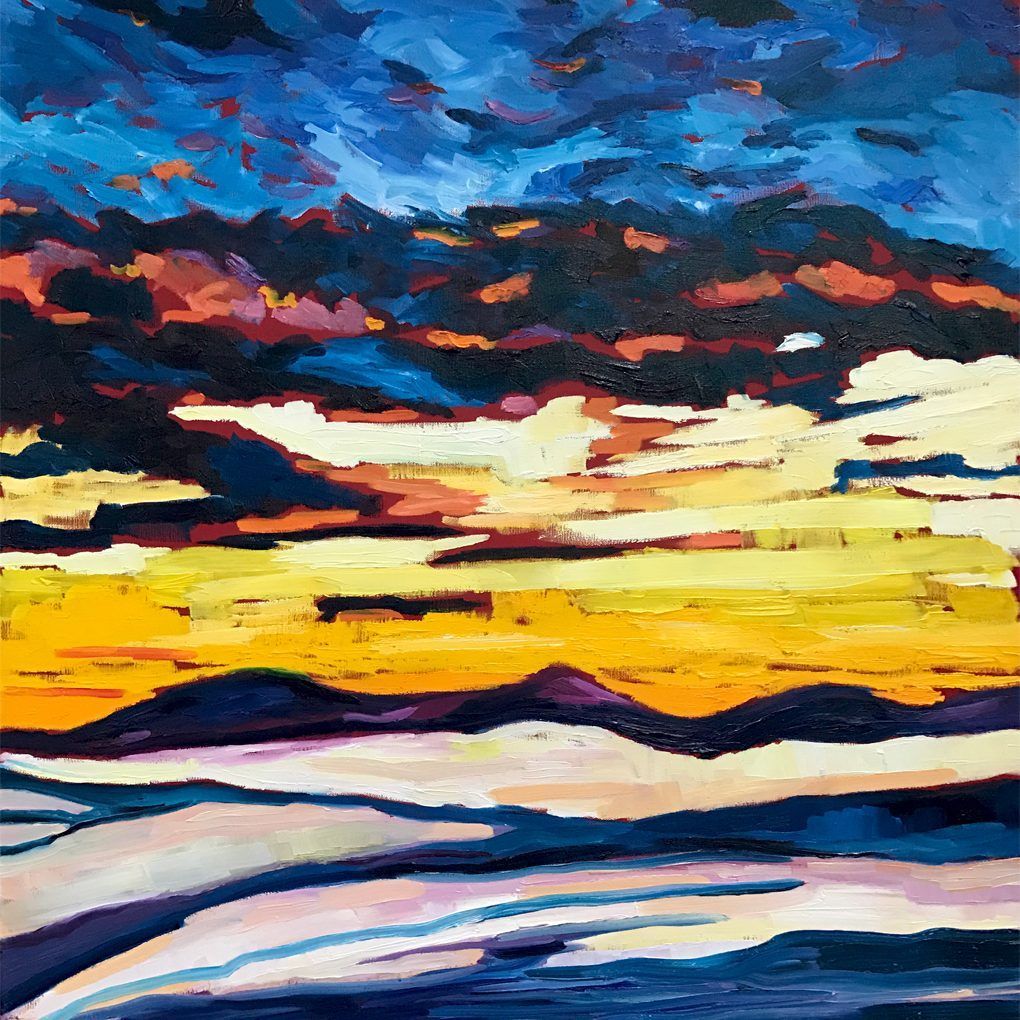Sheyda Ardalan – art professor, painter, sculptor and lover of nature – has just opened a solo painting exhibition at New York’s Prince Street Gallery.
The show, which ends July 8th and is titled “Landscapes,” has received positive advance reviews. The opening reception is on Saturday 24th June.

Kayhan Life caught up with the painter (who lives and works in Connecticut) as she was getting ready for her exhibition.
Talk to us about your show.
The great thing about the Prince Street Gallery is that it was created by a group of New York City artists in 1970 and is run by member artists. I have known one of the members for over 30 years, and she has always encouraged me to apply for a guest spot. I was busy either with my full-time work as a public school art teacher or as a college professor.
Last year, on one of my visits to the Prince Street Gallery with friends, I was encouraged again to apply, and so I did. I just went into my studio at every opportunity and painted, painted, and painted for almost a year.
The paintings on your website are mostly landscapes in vivid colors.
I love looking at landscapes, and find more things to play with in landscapes than in figures or a still life. I remember the first landscape I painted was in Iran when I was around eight years old. We would go to the Caspian Sea during the summer, and I would look at the mountains and paint them, over and over again, with the sea all around.
I use intense colors to describe light, space, and mood in my landscapes. I take colors found in nature and intensify them, applying saturated colors instead of traditional ones. This preference for pictorial flatness and intense colors is a result of my exposure to Persian crafts, especially Persian carpets and traditional textiles.
You often travel back and forth to Iran. What is your impression of the contemporary art scene there, and would you consider having a show in Iran?
Currently, there is an abundance of art being created by artists in Iran that was absent when I was a teenager living in Tehran in the early ‘70s. I think it’s great that artists – for the most part – have departed from the safe zone and are pushing the envelope, experimenting with their work and evolving as they go along.
I would be honored to have a show in Iran. I really would like to see that happening in the future. Most of all, I would love to have a show in Sanandaj, Kurdistan, where my father was from. When I was working on my dissertation, I worked very closely with Hadi Ziaoddini, a prominent Kurdish artist. He always suggests having a show in Sanandaj with him. That would really be nice.
I would also like to go back to Iran and start giving free art workshops in the villages again. I did that for a few years, and it was an incredible experience for me. Working with a friend, we would provide all of the materials, and set up chairs and tables in the village, usually in the fields. Locals would spread the news, and people of all ages, ranging from three to 80, would come to have a day of creative experience. It was phenomenal.
Where were you born, raised and educated?
I was raised in many countries. I am what you call a Third Culture Kid: a child who has lived their developing years (or adolescence) in a country with a culture different from their parents’.
I was born in London, England. My father was a diplomat for the government of Iran and had been transferred to Switzerland right before my birth. As soon as I was born, my mother, my older sister, and I left for Bern, Switzerland. I lived in Switzerland until I was almost two.
When I was four, my father was posted to Cairo, where we lived for two years. Later, we lived in Turkey, then in Madrid. I came of age in Spain, having lived there from the age of 14 to 16. It is a country I will always love.
When we returned to Iran, I was in high school and struggling. My father was sent to Pakistan, but we stayed in Iran for the year that he was gone.
I changed schools nine times before I graduated from high school, going through the British, Iranian, and international school systems.
I graduated from Iranzamin, Tehran International School, and attended the Pratt Institute in Brooklyn, New York to study fine art. Later, I received my masters and doctorate from Teachers College, Columbia University.

How did you develop an interest in art?
As far as I can remember, I have loved to paint and draw. There are pictures of me sitting by the pyramids in Giza, drawing away at the age of four. My mother says that in first grade, I would plead with her not to do my Iranian mashgh, or homework, where we had to write and rewrite a text over and over again. I would tell her my hand hurt. She says she would then catch me drawing in my room with the same hand that hurt.
I had learned writing in English, and switching to reverse writing [in Persian script] was strenuous for me. Drawing and painting was free-flowing, without serious restriction to the direction of the lines or movements needed to create them.
When I first graduated from Pratt, I worked as a graphic artist in New York for the Institute for Architecture and Urban Studies. I worked for their monthly architecture newspaper, Skyline Magazine. After a few years, my husband and I started our family and moved to Connecticut. I stopped working and devoted my time as a full-time mother, occasionally painting and picking up freelance graphic work.
When my children entered elementary school, I started graduate school, and started teaching. Still, I always painted at home in my studio.
When I was driving around Iran, gathering data for my doctoral research on mentorship and apprenticeship in the traditional crafts of Iran, I sketched much of the Iranian landscape using watercolors. I met some of the best people, who opened their workplace to me and allowed me to investigate mentorship and apprenticeship methods. I also learned quite a bit about the traditional crafts of Iran. To this day, I’m still in touch with these craft masters and speak to them regularly on the phone or visit them when I’m in Iran.
What message do you have for our readers and especially for young and inspiring artists?
Don’t hesitate to be creative. You don’t have to be a professional artist to make art and nurture your creative impulses, and be comfortable with trial and error.
I don’t believe art is just for a selected few “talented” people. That’s a myth. Everyone is creative, and can generate images using materials. The problem is that we hold criteria and judgments, and evaluate works of art produced by students based on those criteria – for example the likeness of a drawing to reality. This kind of thinking overlooks crucial aspects such as inventiveness, originality, uniqueness, and personal expression, which are fundamental to any artist, professional or not. When teaching art becomes book-based, and looks at a given set of standards to evaluate student work, then the spark is removed, the flow of idea is lost, and the student loses interest.
I have a message for parents. Provide your children with a safe environment to explore their creative thinking abilities and grow. Channel their strengths and empower them in what they want to pursue. Too often parents tell me that they won’t support their child’s desire to study art because there are no job opportunities. Well, that’s not true. There are many job opportunities for artists, especially within the digital realm. Parents just have to be willing to support their children in their decision – provide them with guidance and nurture them so that they are willing to work hard for their art and suffer a bit for it.
In this day and age of technology, it seems that everyone is eager to make lots of money in a very short time. That is not the case for the artist. It is not the case for most professions.
More of Sheyda Ardalan’s “Landscapes”
#sheydaardalan #princestreetgallery #modernart #iranianartist#iranianamerican #landscapes #landscapeartist #izaa #izaa2016 #nycartgallery #newyorkgalley #artgallery #soloshow #caspiansea#timothyclarke #fredparvaneh #sculptor #iranzamin#tehraninternationalschool #iran #kurdistan #persianart



